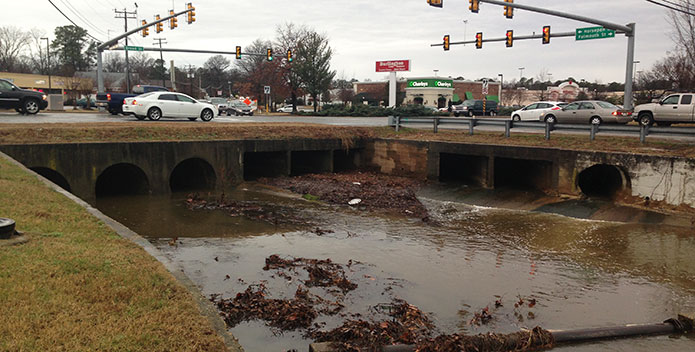The following first appeared in, Richmond Times Dispatch.
Clean water is one topic that Virginians of all political stripes agree on. In fact, pollution in local rivers, streams, and lakes is an important issue for 98 percent of Virginia voters, according to a 2017 poll by the Wason Center for Public Policy and the Virginia Environmental Endowment. Fortunately, this General Assembly session Virginia legislators have the opportunity to invest in the Stormwater Local Assistance Fund, a highly competitive grant program to help communities reduce pollution and restore local waterways.
These matching grants have helped localities implement more than 175 projects that clean waterways, reduce flooding, and beautify communities. For example, the Town of Kilmarnock used the grant to restore nearly 1,000 linear feet of badly eroded headwater streams. A James City County project reduced neighborhood flooding with a rain garden and a network of cascading rocky pools that also capture and filter out pollutants. The city of Waynesboro used the grants to transform a vacant field into a 10-acre wetland that absorbs pollution, provides wildlife habitat, and anchors a new community park.
Given these successful projects, the Chesapeake Bay Foundation hopes the General Assembly will recognize the value of this program to waters across the commonwealth and will prioritize this investment.
The commonwealth has a solid track record of wise investments to reduce pollution from wastewater treatment plants. That same level of commitment is needed now to address the vexing problem of polluted runoff from stormwater.
Many cities and suburbs were built before we understood the impact of cement and asphalt on the health of our waterways. Every time it rains, a network of hardened channels — gutters, culverts, streets, and storm drains — washes a toxic mix of fertilizer, dog waste, sediment, and other pollutants directly to our streams. We know now that green infrastructure — practices that absorb and filter out pollutants — can improve the health of local streams, rivers, and the Chesapeake Bay.
Restoring degraded waterways is also good for Virginia's economy. Outdoor recreation accounts for $21.9 billion in consumer spending and 197,000 jobs in Virginia. From trout fishing in mountain streams to birding on the Eastern Shore, families flock to Virginia to enjoy its natural resources. Employers move here to provide a quality of life for their employees.
"What we are finding is that a clean Bay makes good business sense," said Virginia Chamber of Commerce Executive Vice President Keith Martin. "There is a business case to be made for a healthy, clean, sustainable Chesapeake Bay."
Clean water is within reach. Virginia has made tremendous progress in reducing the flow of excess nutrients to our waterways. Consistent and repeated investments in upgrading wastewater treatment plants have dramatically reduced nitrogen and phosphorus pollution to Virginia's rivers and streams. Fewer nutrients means fewer algal blooms that cloud the water and create "dead zones" where there's not enough oxygen for fish, crabs, or oysters to survive.
Recent upgrades to facilities in Richmond and Hopewell have made a huge difference for the James River. Since 2006, annual nitrogen pollution from the Richmond treatment plant has been cut by 84 percent. An improved James has become an attraction for the many Richmond visitors and residents who hike, paddle, and swim the river.
Despite this progress, recovery is still fragile. Virginia legislators need to commit to investing in the Stormwater Local Assistance Fund on a level on par with investments made in wastewater treatment plants. The grant program has helped 47 localities across the commonwealth tackle polluted runoff. Continued success will only come with support from legislators this General Assembly session.
Millions of Virginians get their drinking water from our rivers and streams. Our waterways provide a sense of place and offer a continual chance at renewal. Our hope for the new year is that we seize this opportunity to ensure the Bay and all of Virginia's waterways are restored so we can leave a legacy of clean water for our children and grandchildren.
Rebecca LePrell Tomazin is the Virginia executive director for the Chesapeake Bay Foundation. She can be reached at RTomazin@cbf.org.

Issues in this Post
Runoff Pollution Chesapeake Clean Water Blueprint Runoff Pollution Water Quality CBF in Virginia



